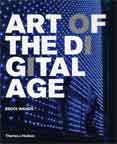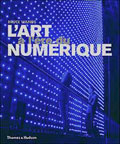![]()
2006
Bruce Wands, Art in the Digital Era, (London , Thames and Hudson) pp. 10 & 33.

![]() This aptly named book provides a broad overview and sampling of digital art. Editor Wands (chair, master of fine arts computer art department, Sch. of Visual Arts; Digital Creativity) ably traces the history of digital art, then outlines in several chapters various areas of the field—digital imaging; digital sculpture; digital installation and virtual reality; performance, music, and sound art; software, database, and game art; “net art”; and the future of digital art. Each chapter includes a sampling of photographs by emerging and established artists, although the field is so new that it appears to be difficult to make an honest distinction.
This aptly named book provides a broad overview and sampling of digital art. Editor Wands (chair, master of fine arts computer art department, Sch. of Visual Arts; Digital Creativity) ably traces the history of digital art, then outlines in several chapters various areas of the field—digital imaging; digital sculpture; digital installation and virtual reality; performance, music, and sound art; software, database, and game art; “net art”; and the future of digital art. Each chapter includes a sampling of photographs by emerging and established artists, although the field is so new that it appears to be difficult to make an honest distinction.

![]() Dans une édition claire et richement illustrée, l’artiste et professeur Bruce Wands expose les enjeu actuels de l’art numérique, et ses modes d’application : image, vidéo, sculpture, installation ou performance.
Dans une édition claire et richement illustrée, l’artiste et professeur Bruce Wands expose les enjeu actuels de l’art numérique, et ses modes d’application : image, vidéo, sculpture, installation ou performance.
![]()
![]() SHERBAN EPURÉ, "CONDOTIERRE", 2003. Inkjet, Print, Variable Dimmensions.
SHERBAN EPURÉ, "CONDOTIERRE", 2003. Inkjet, Print, Variable Dimmensions.
Sherban Epuré uses the term "meta-phorms" to describe the results of his mathematically based image-generating process. This work produced using algorithms, is formed by interaction of colour with a simple geometric shape. One intent of Epuré's imaging is to forge a link between Western technology and Eastern spirituality.
page10.
... New digital techniques can be considered as the latest step in an evolutionary process; where traditional drawing and painting methods are constrained by the limitations of physical technique, and photography and video rely on lens-based technologies, digital imaging incorporates elements of mathematical computation and mechanical precision, making possible a whole range of styles from photorealism to pure mathematical abstraction.
The earliest digital printmakers needed to programme the computer before making their drawings because first-generation graphics software did not have interface. After programming, images were output through the use of plotters-devices that draw pictures on paper with a variety of pens or brushes controlled by digital motors. The use of programming to create images continues to the present day, and artist such as Paul Brown (pp. 44-45), Sherban Epuré (p.10), Jean-Pierre Hébert (pp.13,38), Manfred Mohr (pp. 25,63), Michael Trott and Roman Verostko (p.70) all use programming as an integral part of their creative process. ...
page33.